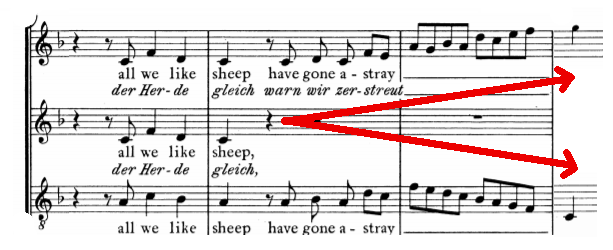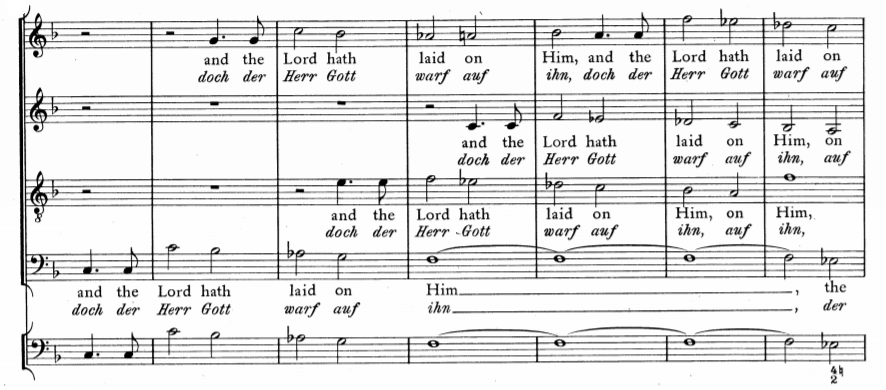<music: J. S. Bach, Brandenburg Concerto No. 1>
Now, I think that perhaps the most famous, extended example of word painting is in the chorus “All We Like Sheep Have Gone Astray.” In “All We Like Sheep Have Gone Astray” we find a whole series of figures. First of all, what about these sheep? The sheep are happy. Listen to the bass line. (music) It’s just (singing) happy go lucky, the bassoon player plays with this great articulation and the cello player plays with nice little short strokes.

It is just fantastic! So, the sheep are happy. In the melody, the first little tune is “All we like sheep have gone astray.” I have sometimes said to kids, young children, “If you had to write that and set it to music, what would you do?” Very few people come up with what Handel did. He takes two lines and has them go apart from each other. How do they go apart? They go apart in little bounding motions, like sheep jumping in the meadow and moving away from each other. So, they start very close (music) and then go away. They go astray. He sets that within the music.

Then he says, “We have turned.” For the word “turned” he writes music that turns. We have…turned, everyone to his own way.

Now, I am just old enough to know who Nikita Khrushchev was. He went to the United Nations and took his shoe off and banged it on a table like this. This is similar to what Handel does in music. (music)

After “we have turned” he says “everyone to his own way.” So, here we have these ideas together: happy sheep (music), have gone astray (music), have turned (music), everyone to his own way (music).
To me here is the miracle of all of this. All of that is happening one after another. To be honest, if I had one of those ideas I would be very proud of myself. Handel puts them together in one piece of music in a way that is so effortless and beautiful that it is easy to miss that great craftmanship of putting them together.
Here are they happy sheep and we are wailing along with all four parts in the choir singing and the orchestra playing and all of a sudden this happens. (music) And the choir sings. (music).

The text is “and the Lord hath laid on Him…: So first of all, here is that over dotted note again, here is the French Overture. The Lord is God. This is an octave. The octave is a symbol of God. It is the first overtone; it is the most perfect interval. God is the most perfect being. Bach and Handel often use octaves when they talk about God. Here is the French Overture, royalty, “and the Lord.” (music) It gets slow, it gets sad. So the happy sheep, bouncing around, going astray, suddenly there is this dramatic illustration of the consequence for a religious person in what all of this means. It is a fantastic, dramatic stroke that is always enormously effective when it happens just over half way through a performance of the Messiah.
Music examples from imslp.org
<music: J. S. Bach, Brandenburg Concerto No. 1>
